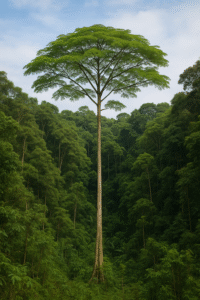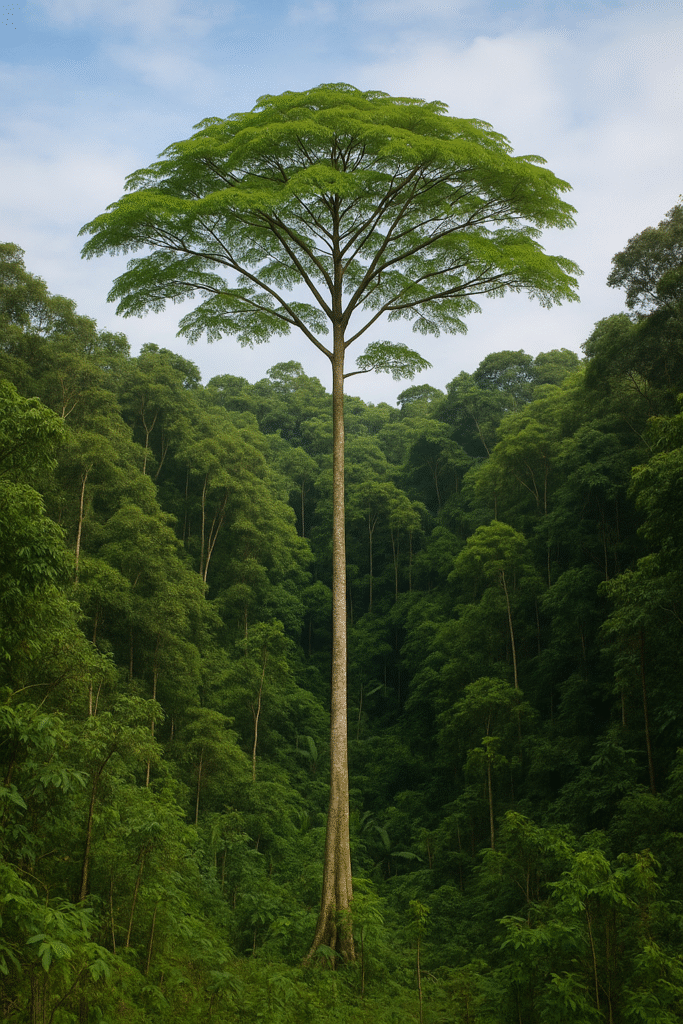The Paricá tree (Schizolobium parahyba) is one of Brazil’s most remarkable native species, widely valued for its ecological importance, rapid growth, and versatile use in the timber industry. Known in English as Paricá tree or Parica wood, this species has attracted attention not only in South America but also in international markets.
In this article, we will explore what Paricá is, why it stands out among tropical trees, and reveal 7 secrets about this fascinating species that most people do not know.
What Is the Paricá Tree?
The Paricá (Schizolobium parahyba) is a tropical tree native to Brazil, particularly common in the Amazon and Atlantic Forest regions. It belongs to the Fabaceae family and is well-known for its extremely fast growth. In ideal conditions, a Paricá tree can reach 30 meters (98 ft) in height within just 10 years, making it one of the fastest-growing hardwood species in the world.
Its wood, often called Parica wood, is lightweight, pale-colored, and easy to work with, which explains its popularity in industries such as plywood, furniture, and paper production. Farmers and reforestation companies also value Paricá for its ability to regenerate degraded soils and contribute to carbon sequestration.
Ecological Importance of Paricá
Paricá is not only useful in commerce—it also plays a major role in the environment. Its wide canopy provides shade and shelter for wildlife, while its nitrogen-fixing ability helps restore soil fertility. Many reforestation projects in Brazil use Paricá as a pioneer species, as it grows quickly in poor soils and prepares the ground for other native trees.
7 Secrets About the Paricá Tree
While many know Paricá as just another tropical tree, there are several lesser-known facts that make it truly special. Here are 7 secrets about the Paricá tree:
1. It Is One of the Fastest-Growing Tropical Trees
Most hardwood trees require decades to reach maturity, but Paricá grows so quickly that it can be harvested within 7 to 10 years. This makes it a sustainable alternative to slower-growing species such as mahogany or oak.
2. Paricá Wood Is Lightweight but Durable
Despite being light in weight, Parica wood is surprisingly resistant when used in furniture and plywood. It is often compared to pine wood, but it offers a smoother finish and a paler tone, which makes it highly desirable for design and decoration.
3. It Plays a Role in Reforestation of Degraded Lands
Because of its nitrogen-fixing properties, Paricá improves soil fertility. This allows other species to grow in areas that were once deforested or degraded, turning it into a key ally in ecological restoration projects.
4. Paricá Leaves Are Used in Traditional Medicine
In some rural communities in Brazil, leaves and bark of Paricá are used in traditional medicine to treat mild inflammation and fevers. While more research is needed, this ethnobotanical use shows how deeply connected local populations are with this tree.
5. Its Seeds Germinate Extremely Fast
Paricá seeds are known for their high germination rate. Under the right conditions, seeds can sprout within a few days, making it one of the easiest species for large-scale planting. This feature explains why Paricá plantations have expanded so quickly in Brazil.
6. It Has a Unique Role in Carbon Sequestration
Due to its rapid growth, Paricá absorbs large amounts of carbon dioxide from the atmosphere in a short period of time. This makes it an important ally in the fight against climate change, helping industries and governments meet sustainability goals.
7. The Wood Is Exported Worldwide
While Paricá is native to Brazil, its wood is exported to many countries. Plywood manufacturers in Asia, Europe, and North America often rely on Parica wood due to its affordability and quality. This makes Paricá not just a Brazilian treasure but also a global commodity.
Paricá and Sustainable Development
One of the greatest advantages of Paricá plantations is their contribution to sustainable forestry. Unlike illegal logging of slow-growing hardwoods, Paricá plantations can be harvested without harming biodiversity. By combining fast growth, ecological restoration, and economic value, Paricá represents a balanced model of forest use.
Challenges of Paricá Cultivation
Despite its many benefits, cultivating Paricá also presents challenges. Farmers must be aware of pests such as leaf-cutting ants and diseases that can affect seedlings. Additionally, improper large-scale monoculture may reduce biodiversity. Therefore, experts recommend planting Paricá alongside other native species to ensure ecological balance.
Conclusion
The Paricá tree (Schizolobium parahyba) is much more than just another tropical species. It is a symbol of fast growth, ecological restoration, and sustainable use of natural resources. From its role in reforestation projects to its increasing demand in the global timber industry, Paricá proves that economic development and environmental care can walk together.
By understanding the 7 secrets of Paricá, we can appreciate not only its commercial value but also its ecological and cultural significance. For those interested in sustainability, tropical forestry, or natural resources, the Paricá tree is truly a species worth knowing.

⛺ Discover the Perfect Shelter for Your Outdoor Adventures!
Whether you’re hiking, camping, or enjoying a weekend getaway, the
Amazon Basics Camping Tent offers durability, comfort, and protection.
With its 3-season dome design and included rainfly, you’ll be ready for any weather.

🌱 Learn How to Keep Your Plants Safe from Curious Pets!
Protecting your plants from playful pets doesn’t have to be difficult.
Check out our complete guide with smart tips and practical solutions
to keep your greenery thriving while keeping your furry friends happy.

